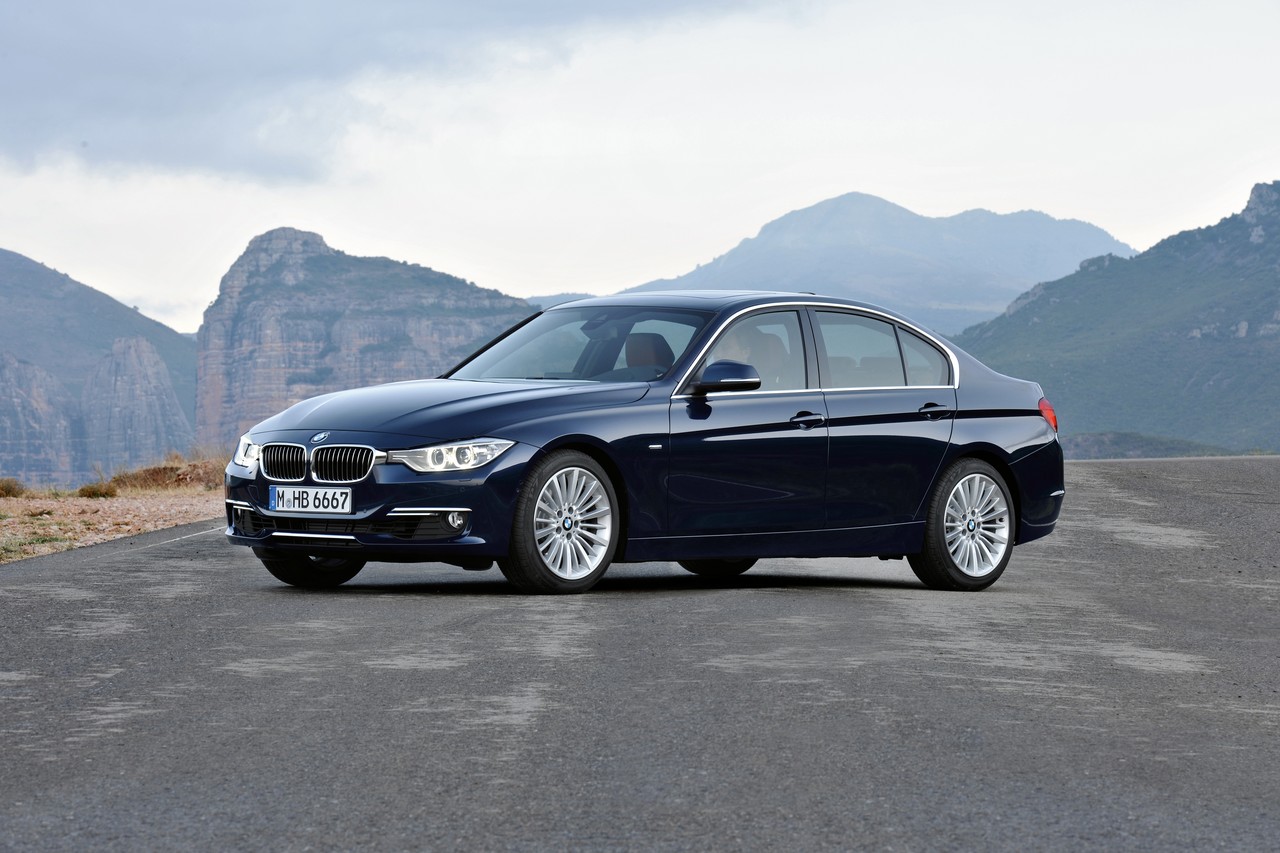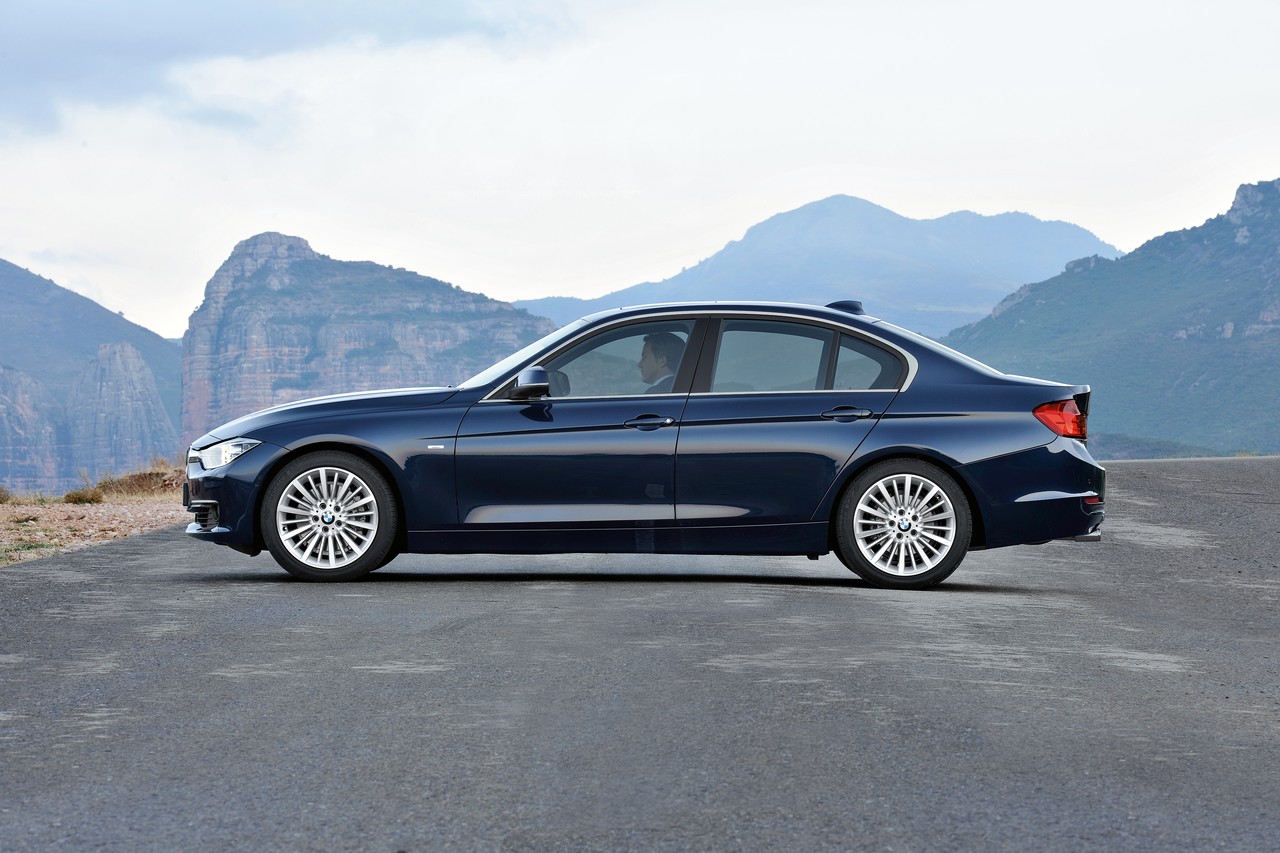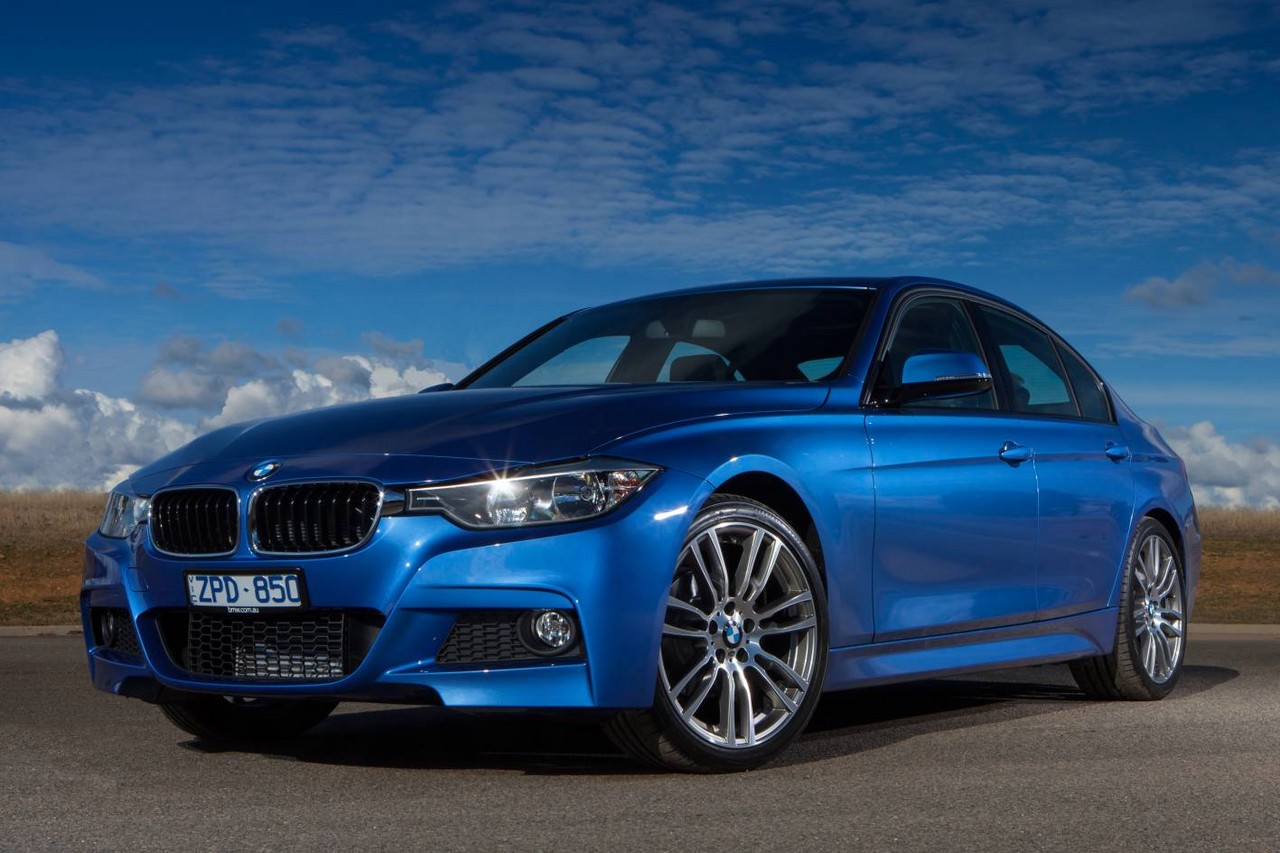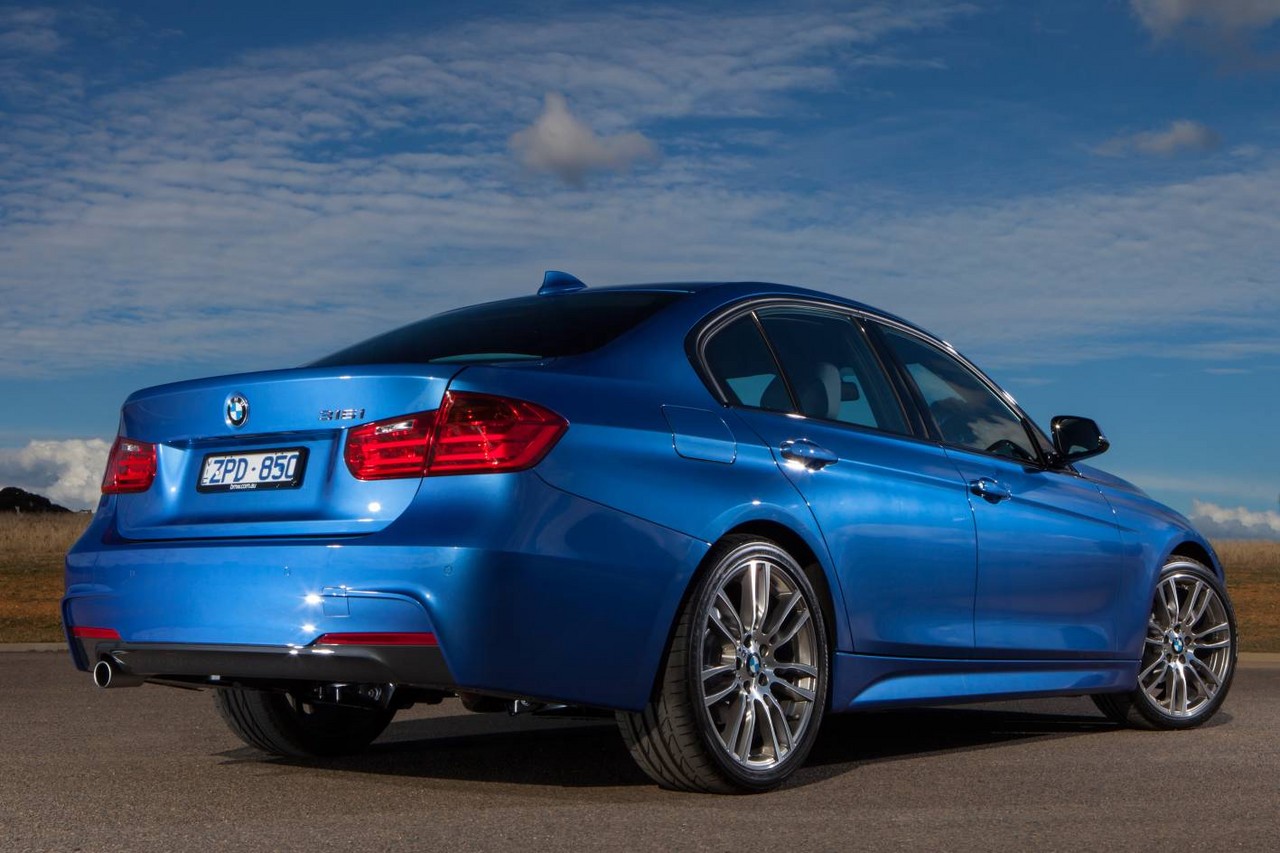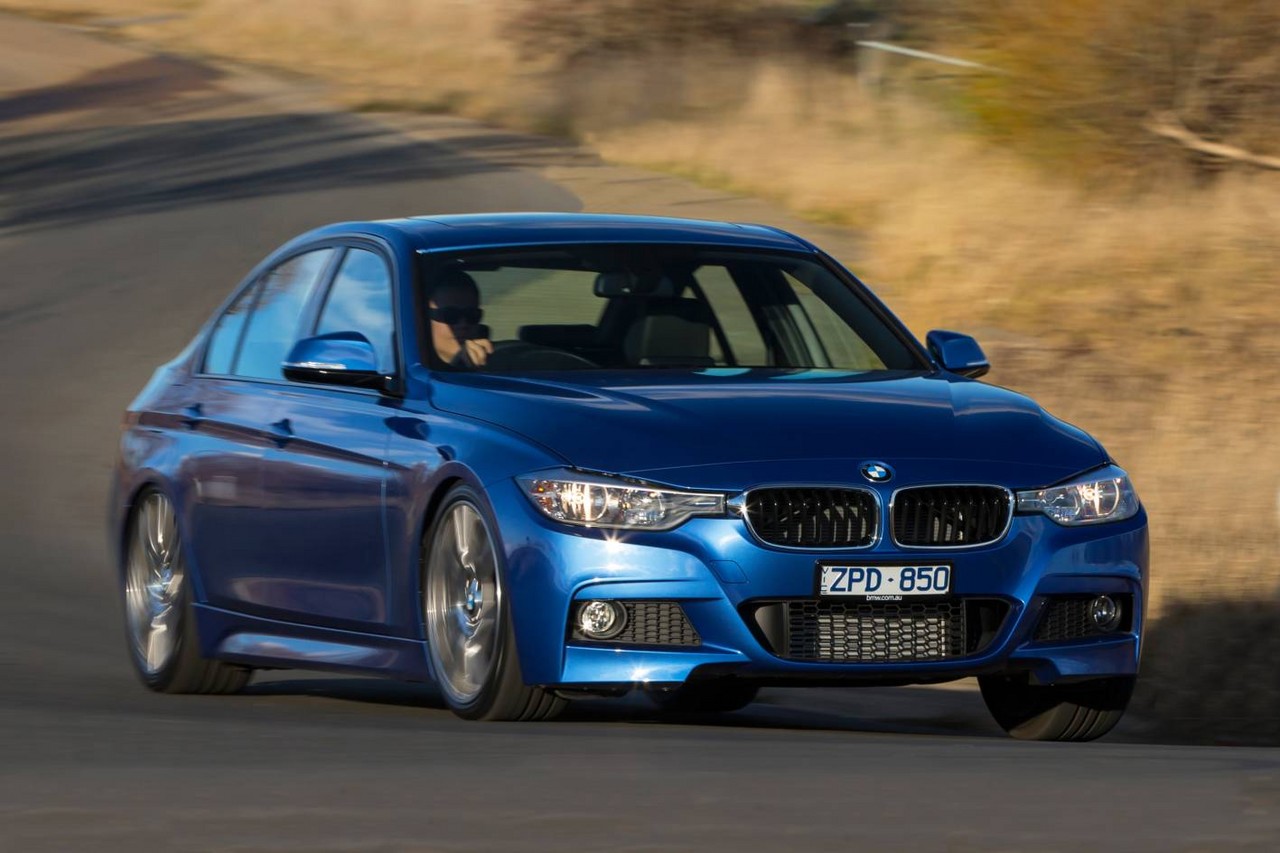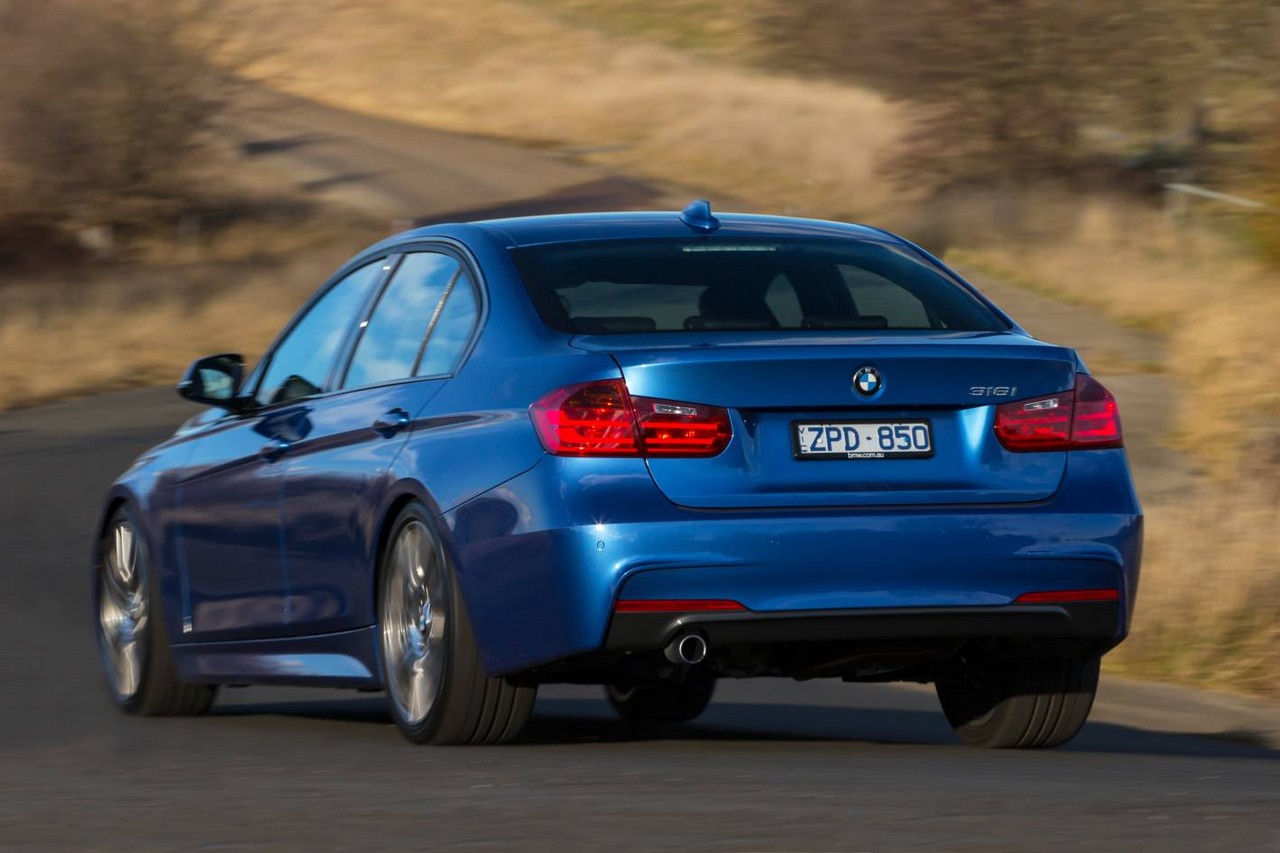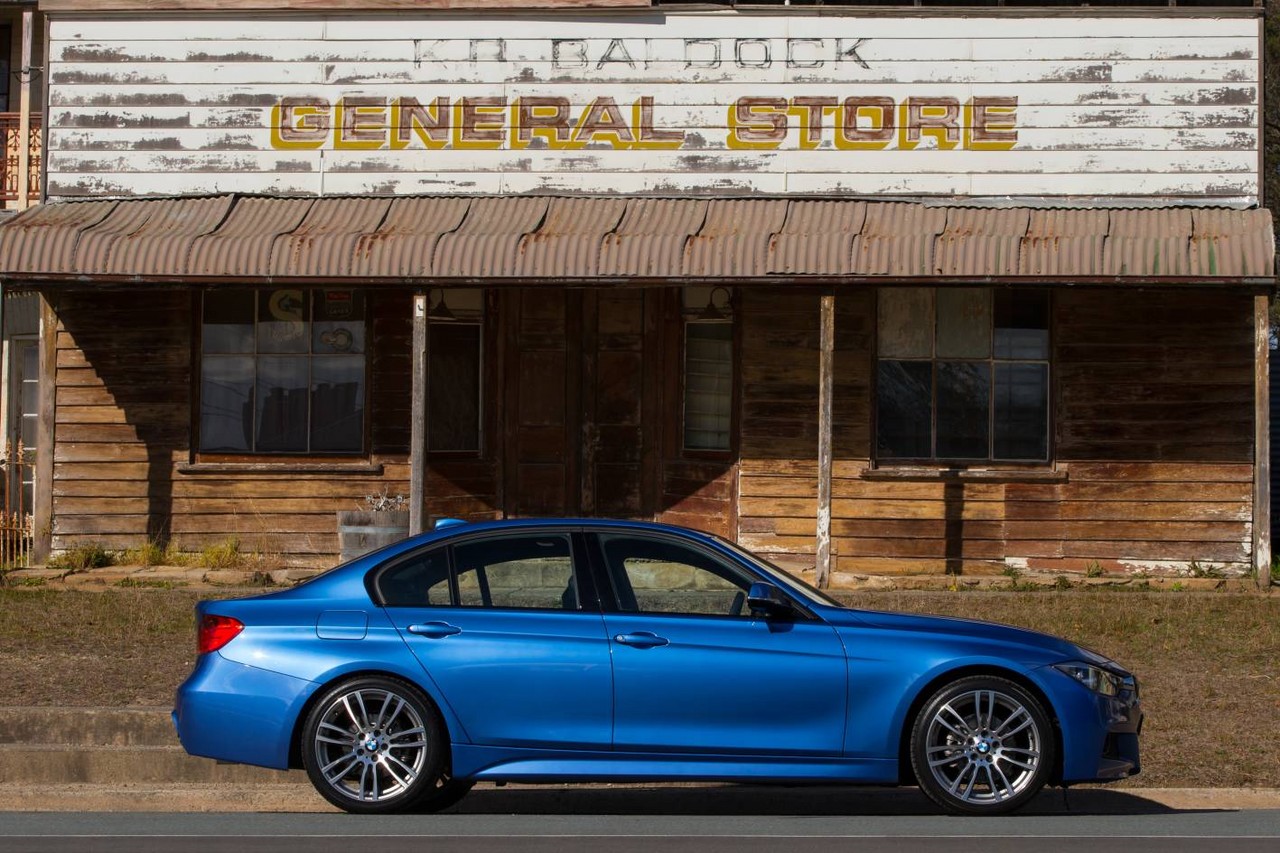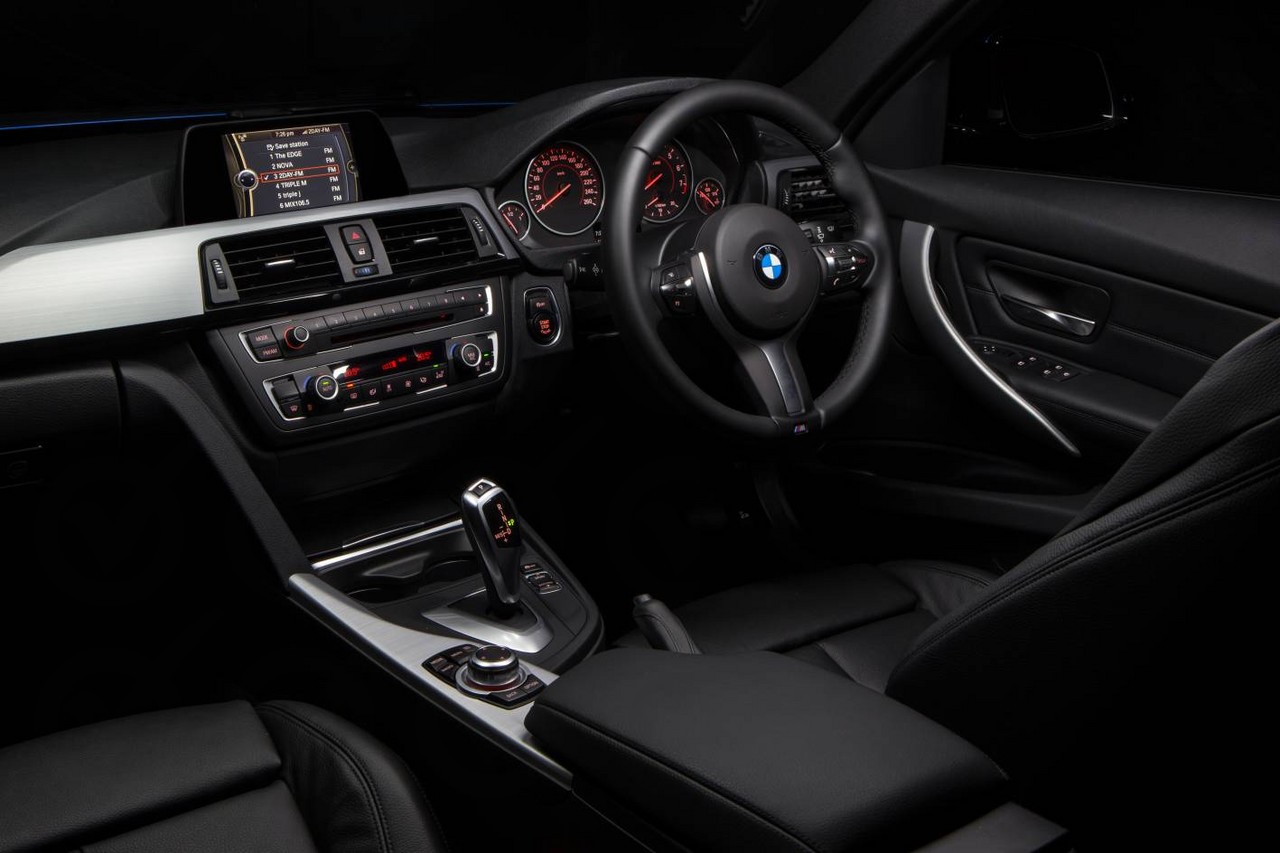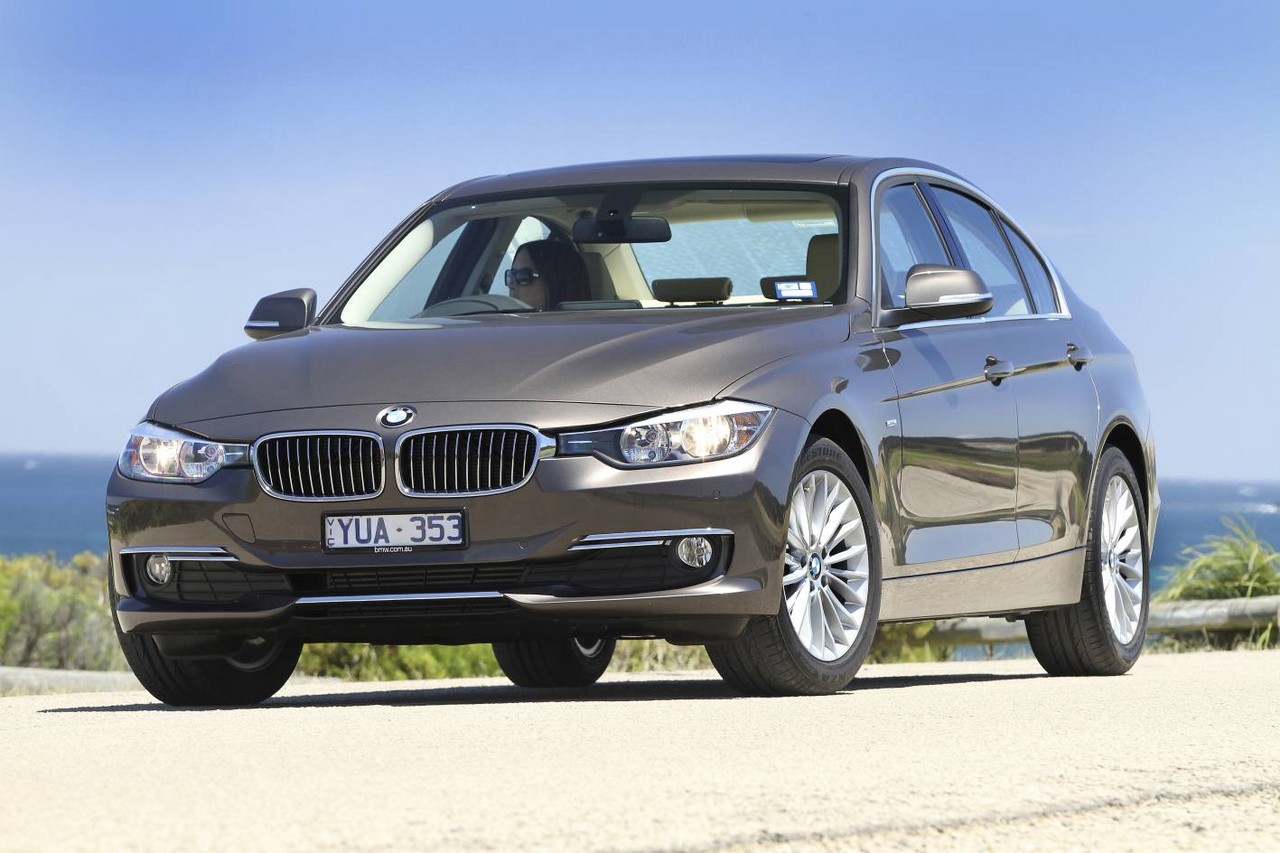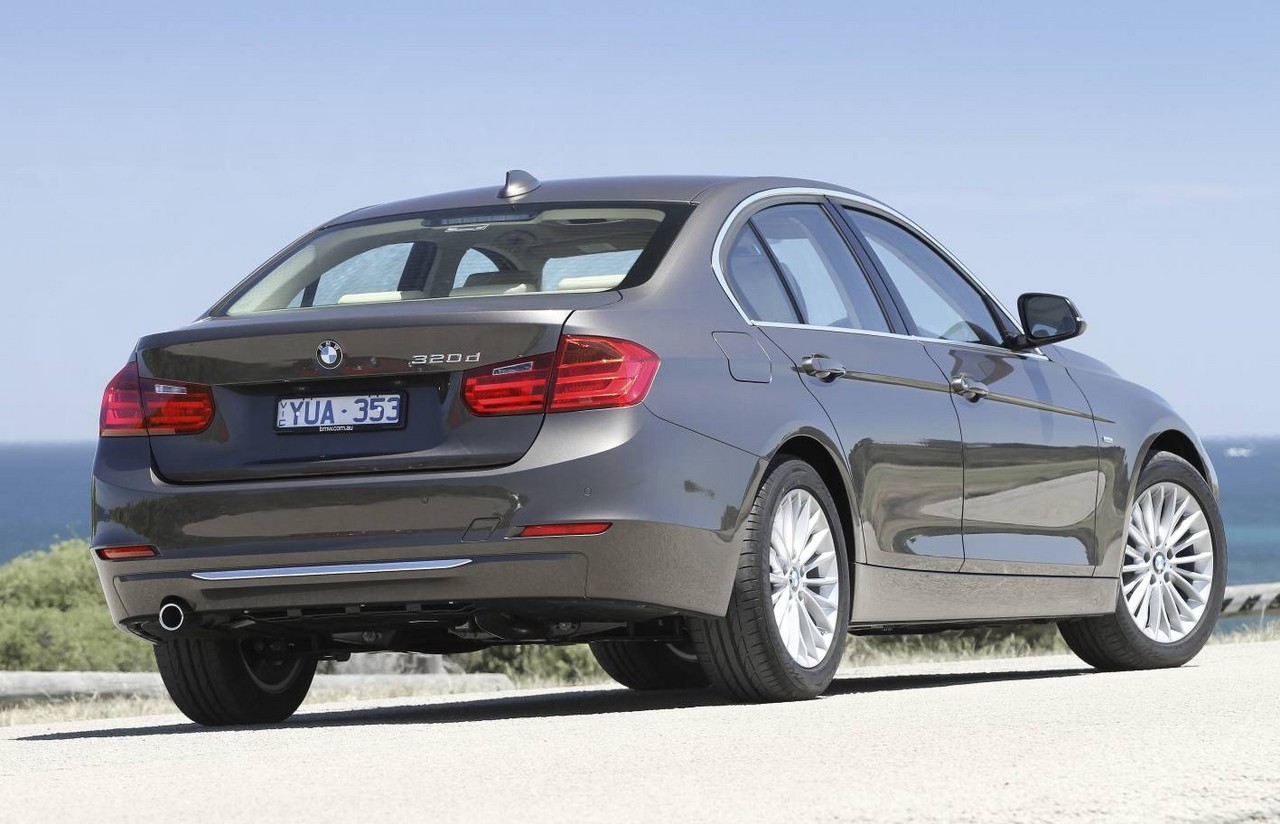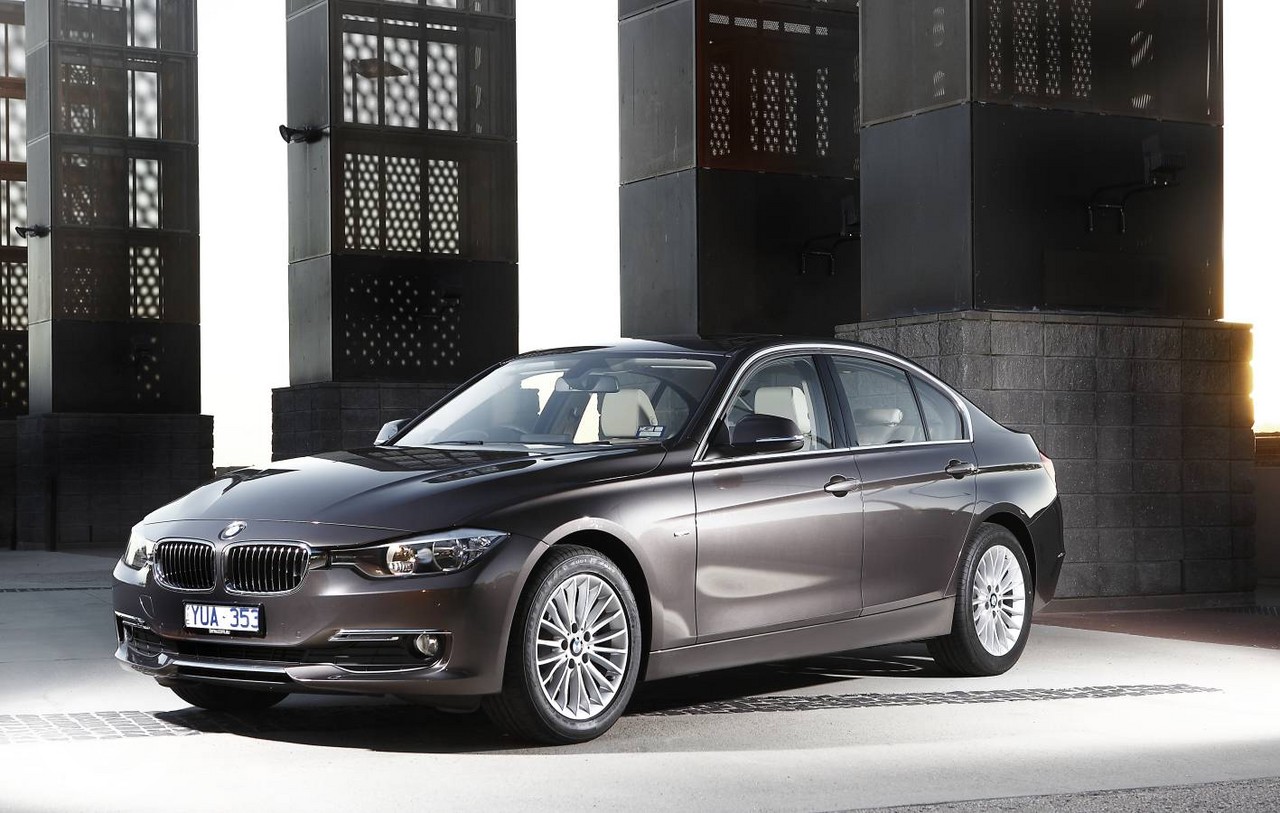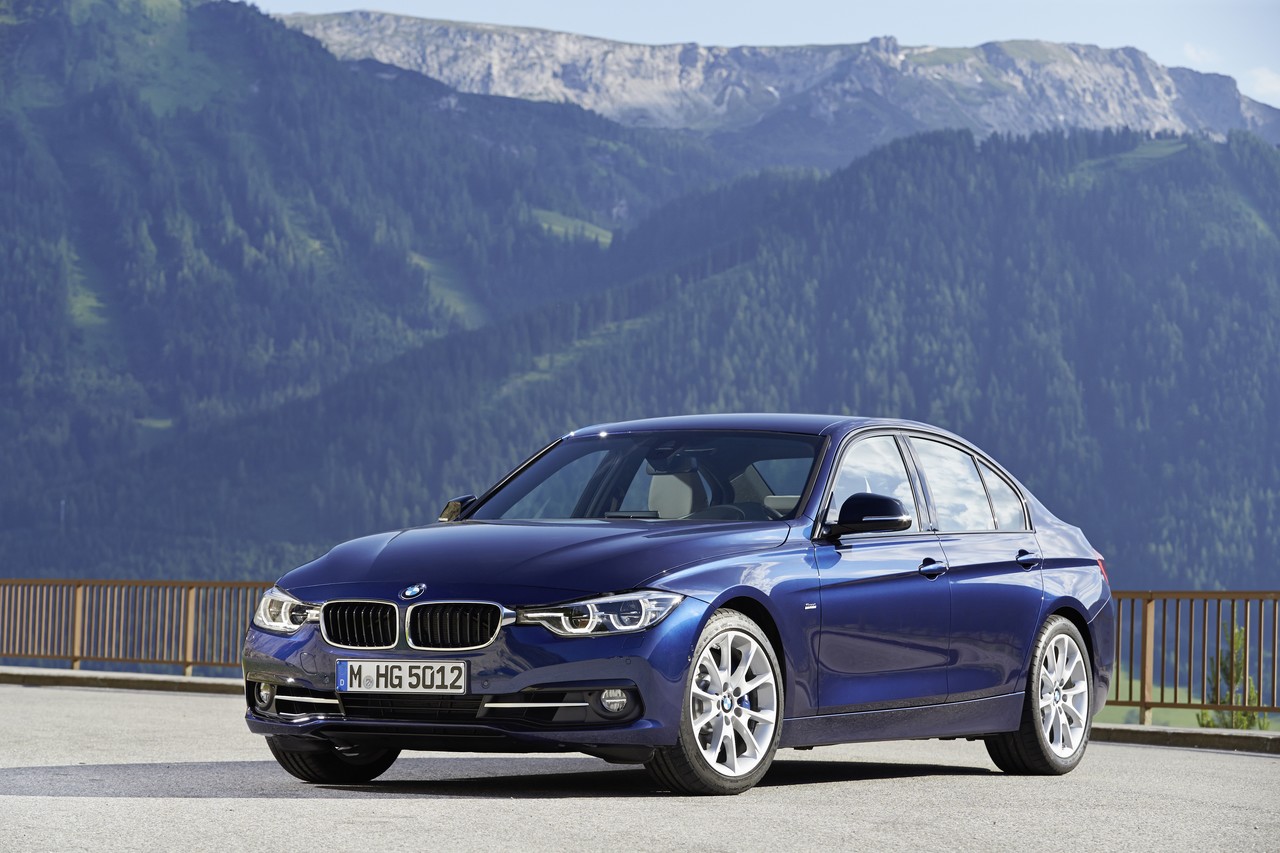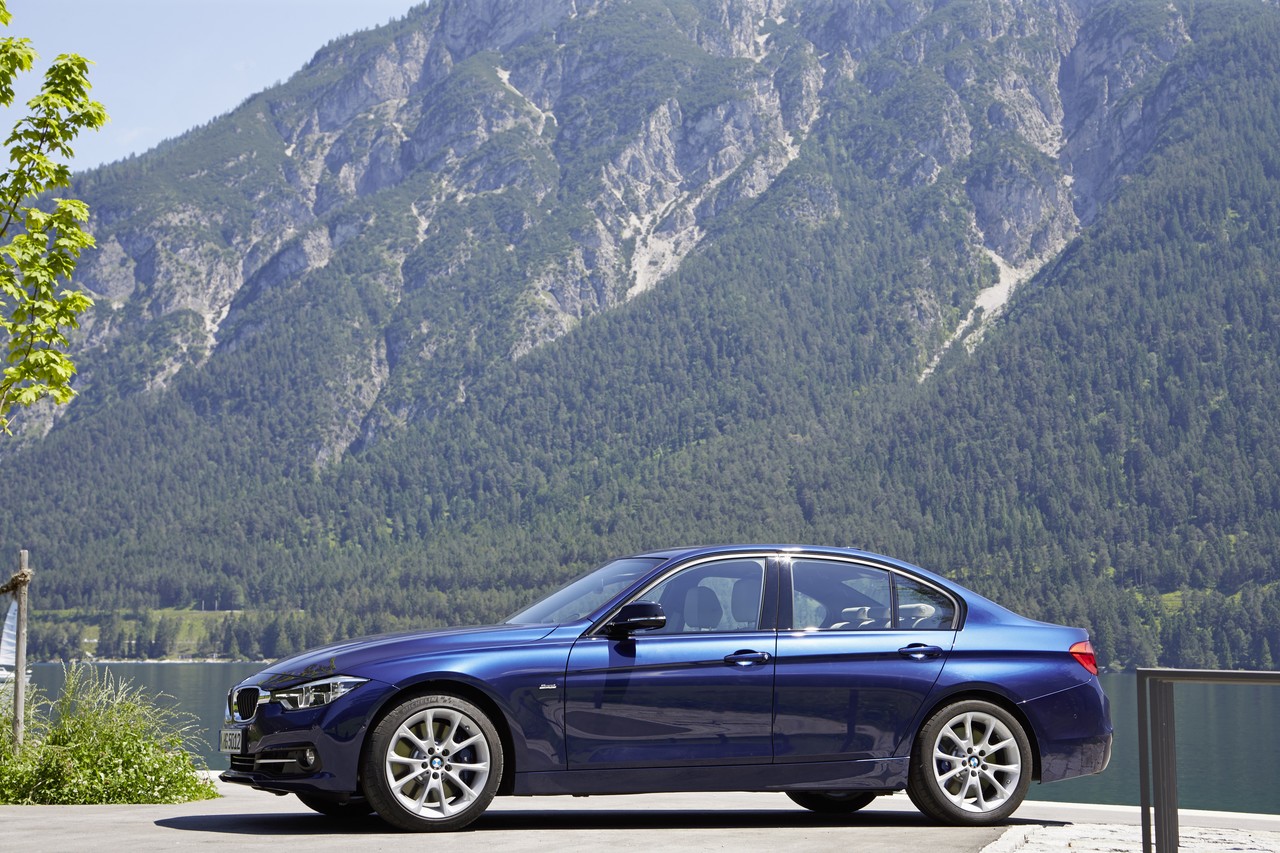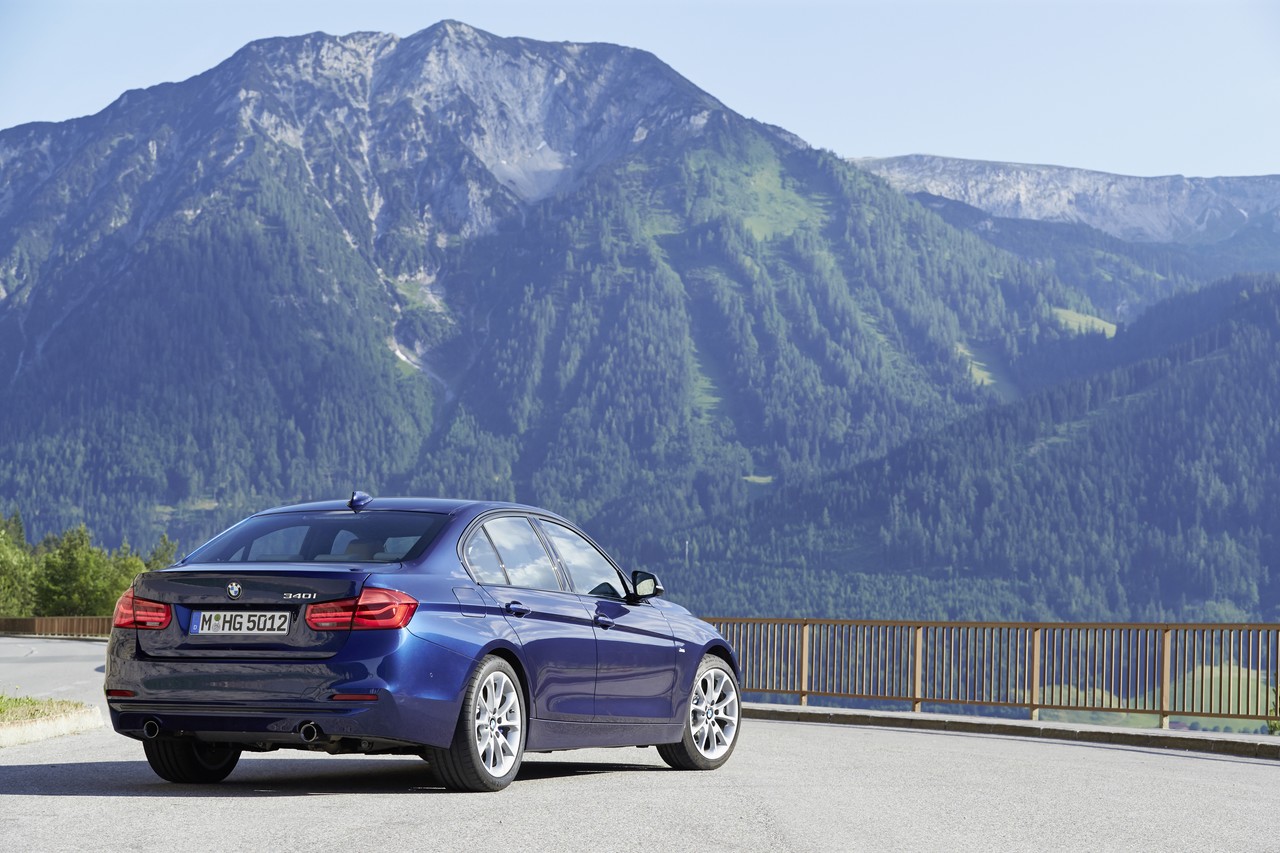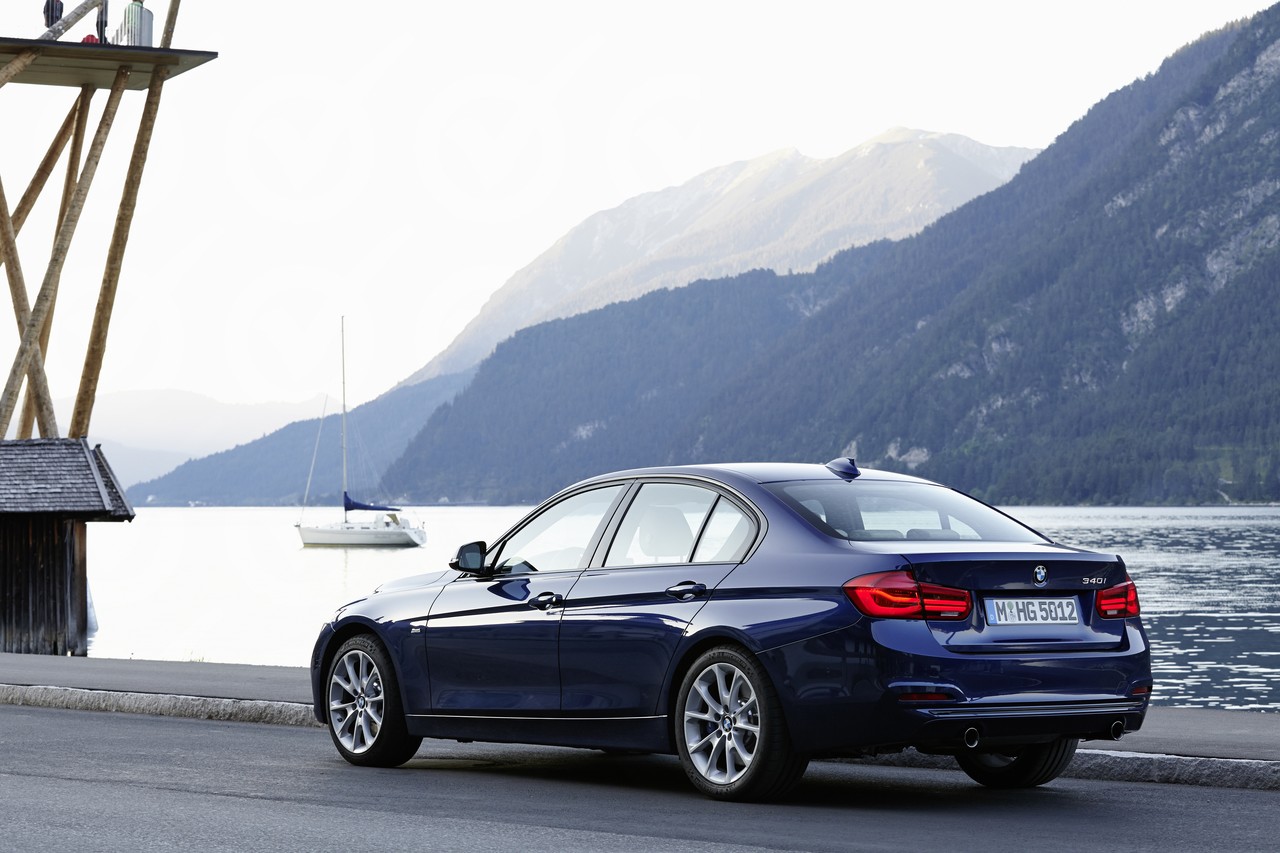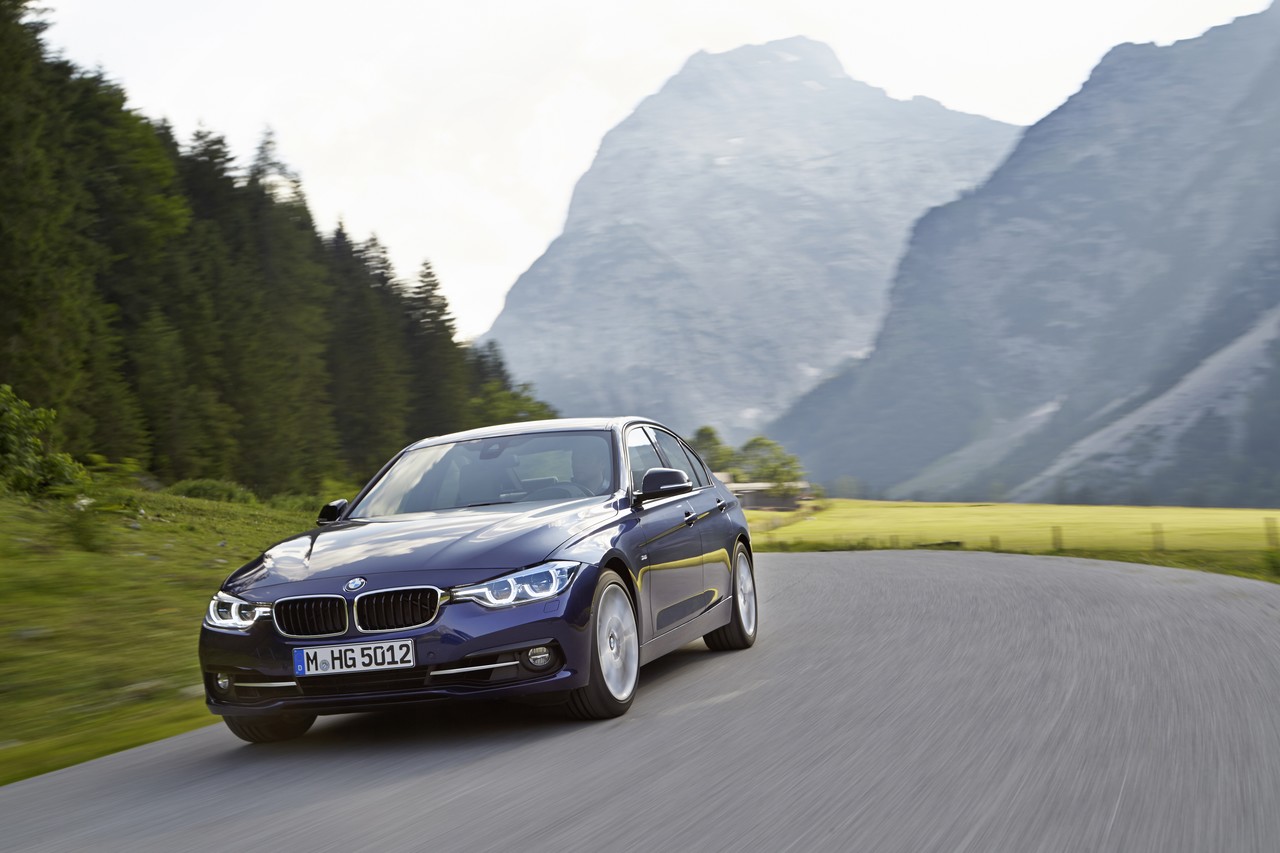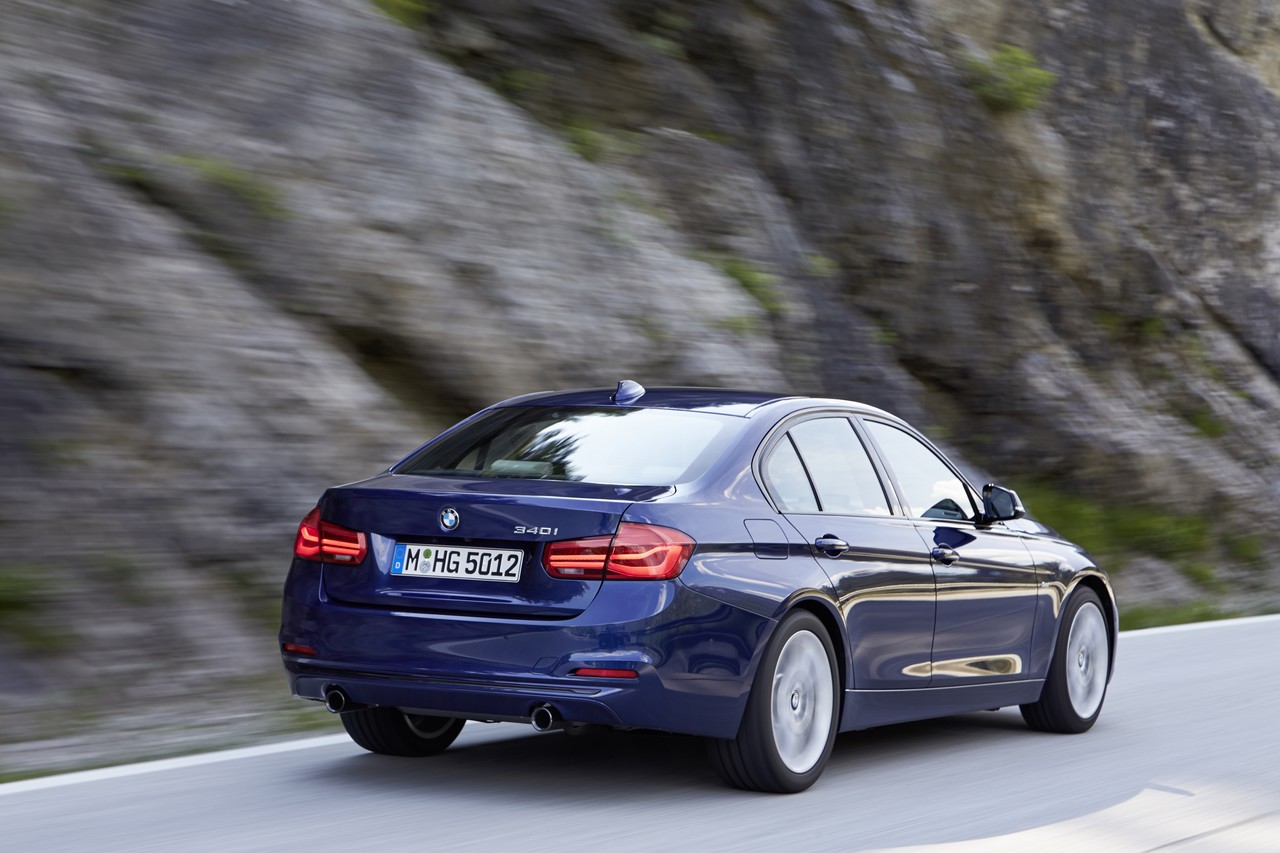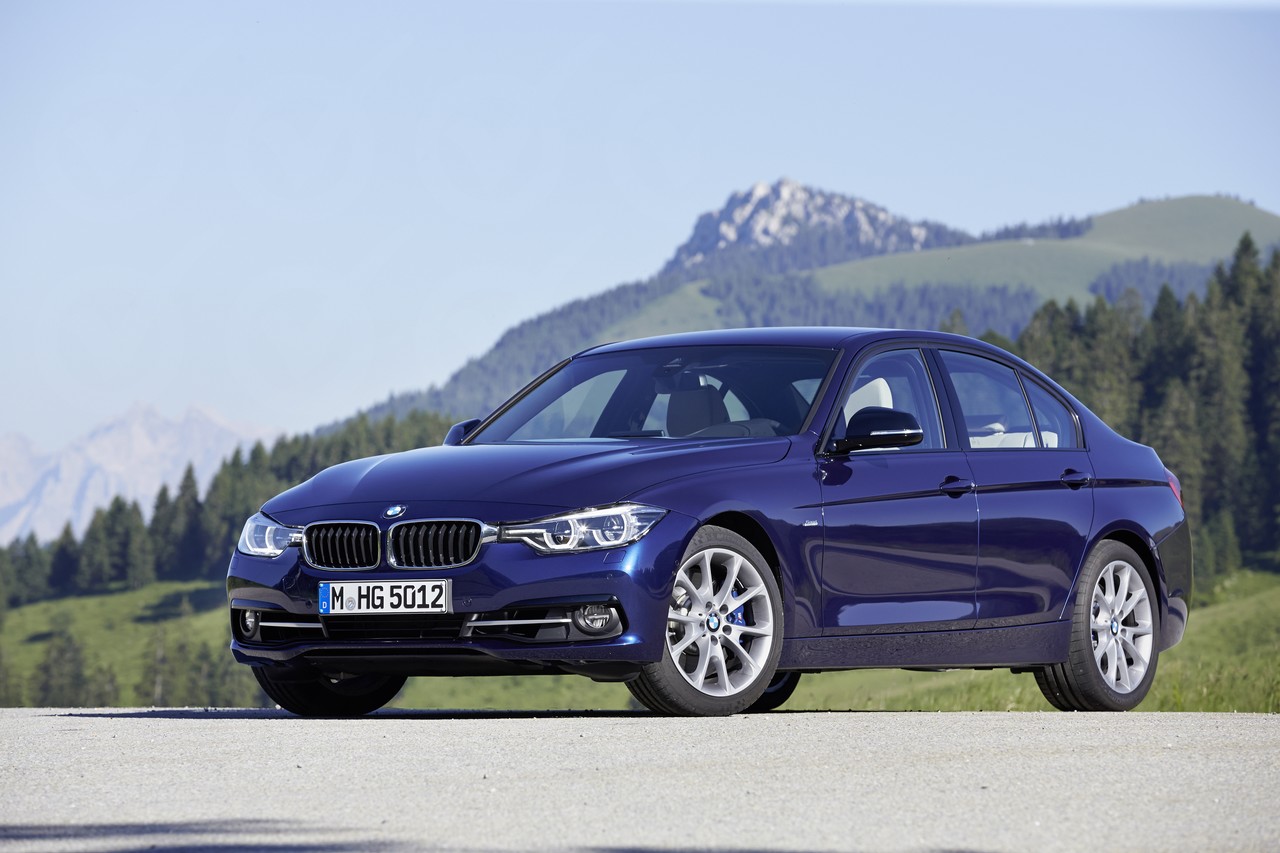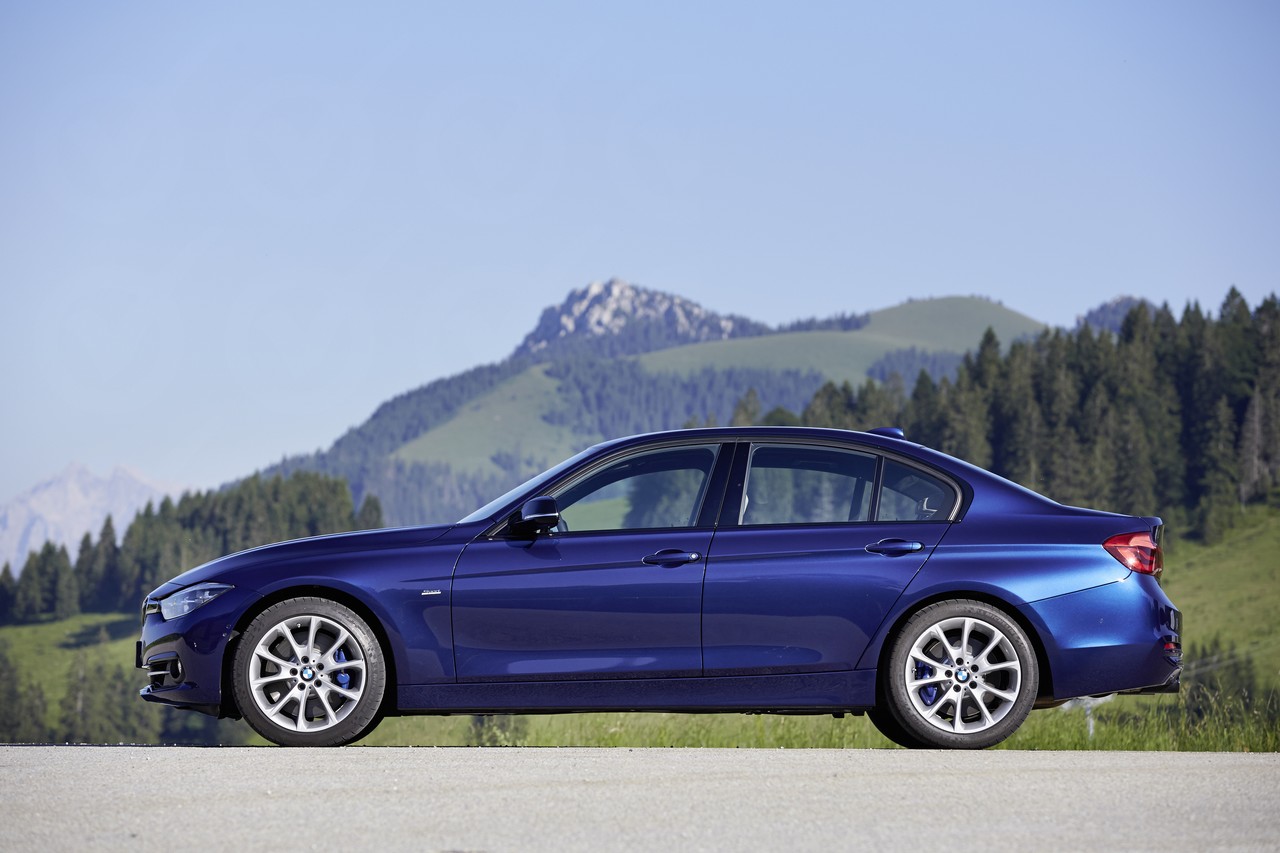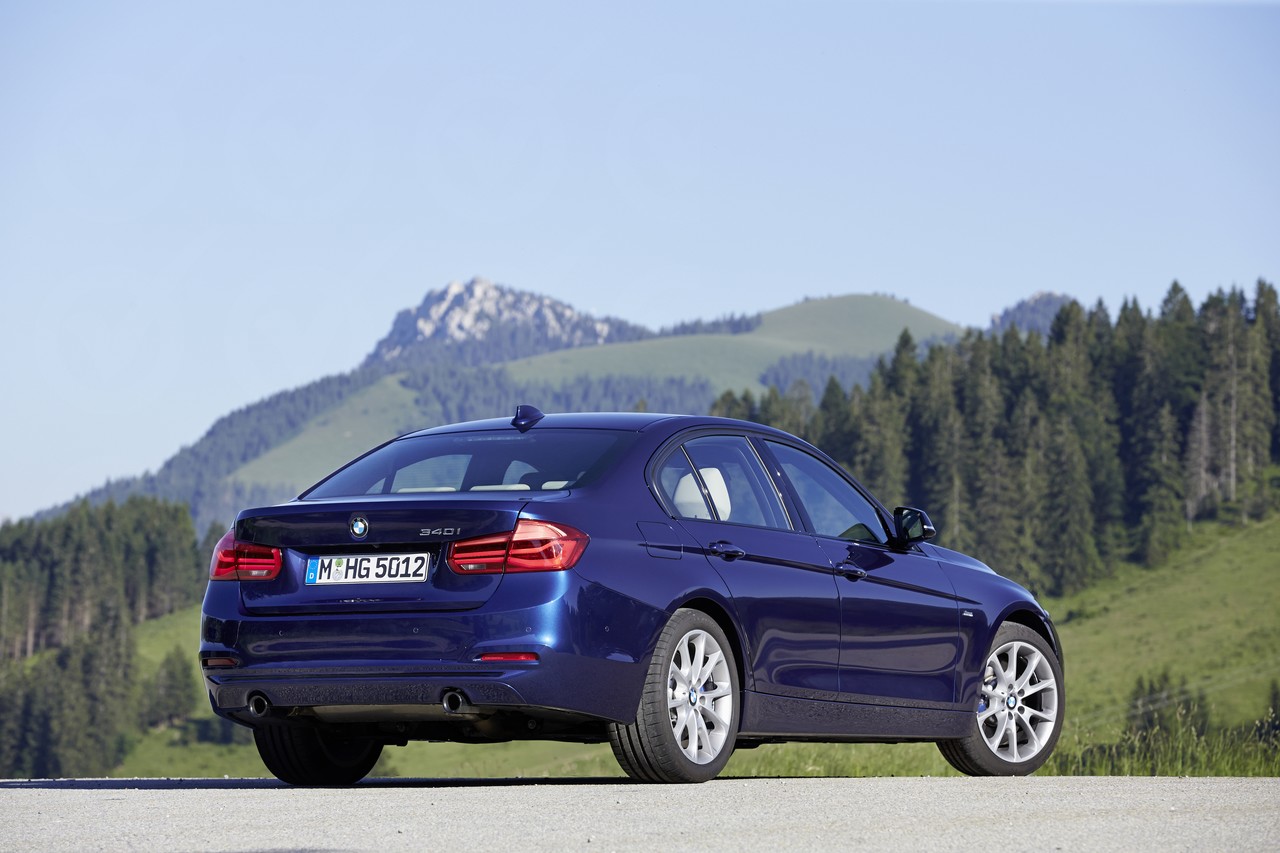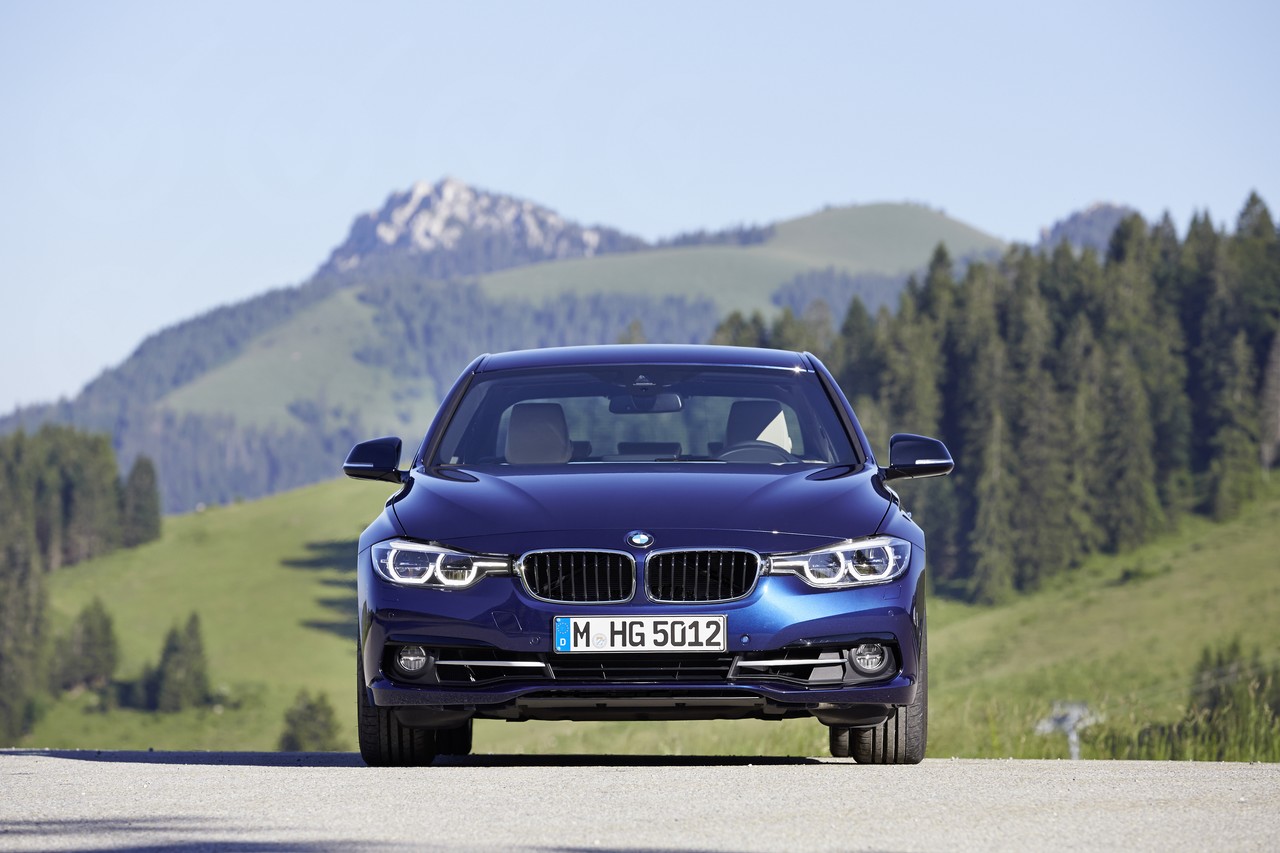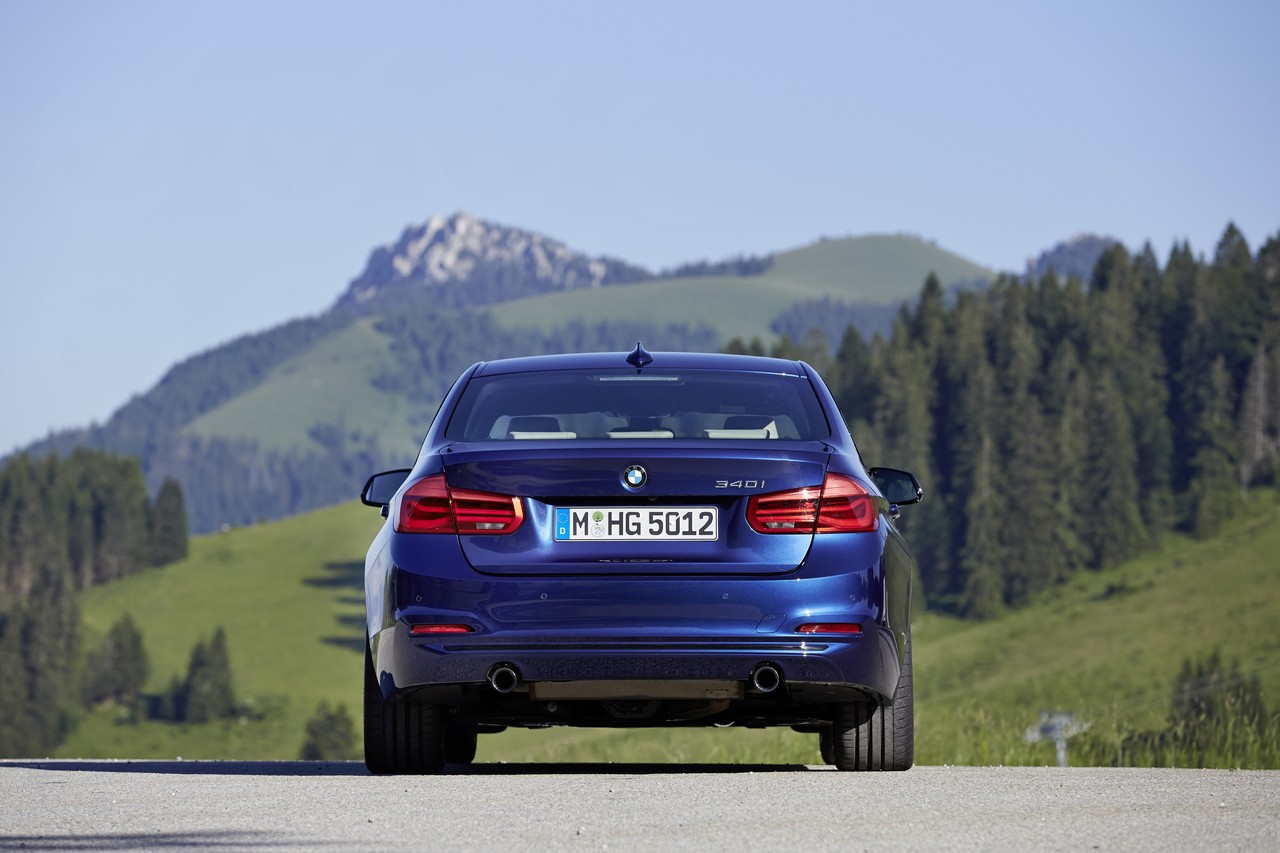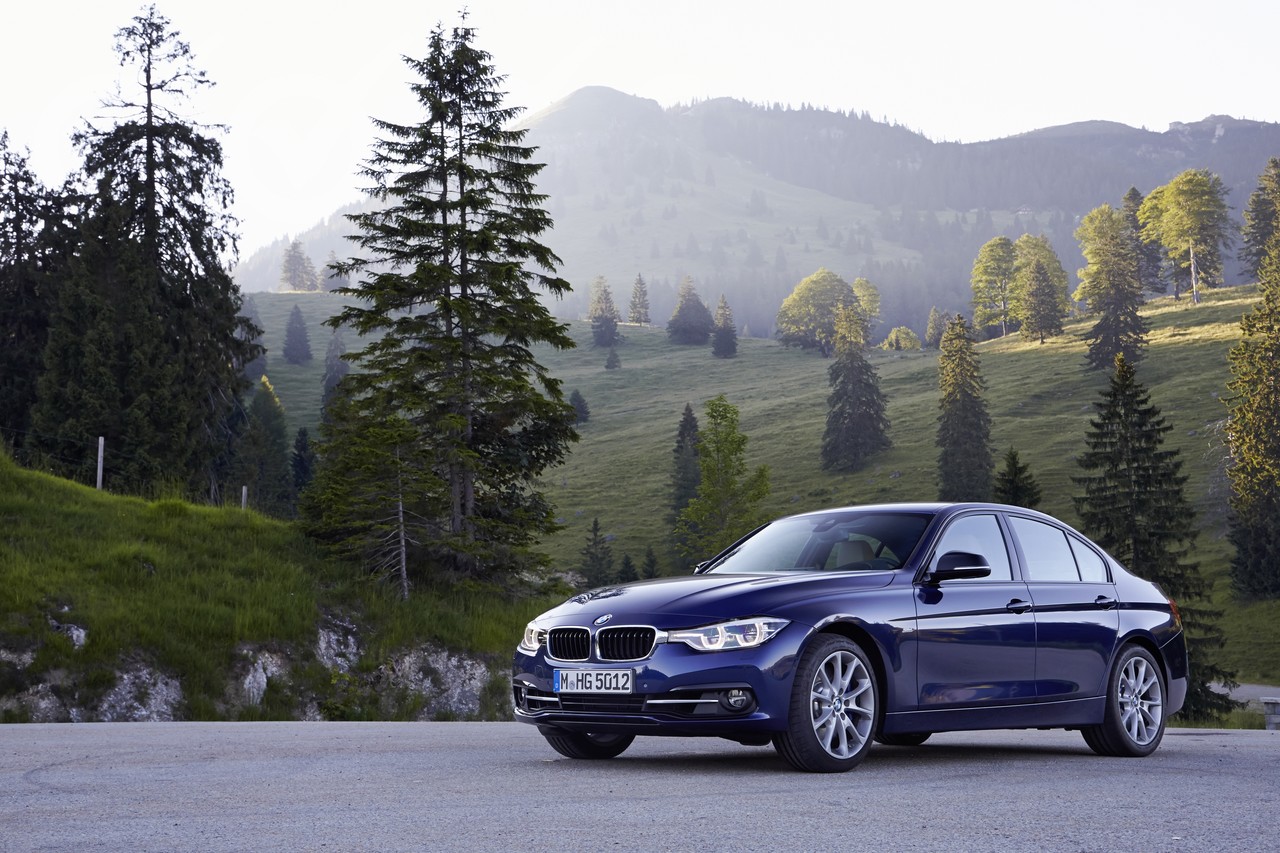
- Frugal turbo-diesel engines
- Responsive turbocharged petrol engines
- Impressive ride/handling balance
- Steering is accurate…
- … but lacks feel
- Suspension lacks low-speed compliance
- Tyre noise
Review: BMW F30 3-Series sedan (2012-15)
Overview
Released in February 2012, the BMW F30 3-Series was a compact executive sedan. Manufactured in Rosslyn, South Africa, the rear-wheel drive BMW F30 3-Series sedan range initially consisted of the 320d, 328i and 335i models, followed by the 318d and 320i in May 2012 and the 316i in June 2013. Of these, the 318d and 320d were powered by 2.0-litre four-cylinder turbo-diesel engines, the 320i and 328i were powered by 2.0-litre turbocharged petrol engines and the 335i had a 3.0-litre turbocharged six cylinder engine.
All models were fitted with BMW’s ‘Auto Start-Stop’ and ‘Brake Energy Regeneration’ functions as standard, while a ‘Driving Experience Control’ switch which enabled the driver to select from Normal, Eco and Sport driving modes.
ActiveHybrid 3
Released in late 2012, the German-built ActiveHybrid 3 was powered by a 3.0-litre turbocharged inline six-cylinder engine and a 40 kW synchronous electric motor which drew power from a 675 Wh lithium-ion battery pack that was located under the boot.
When coasting or braking, the electric motor acted as a generator to recharge the battery. Under acceleration, however, the electric motor operated to provide additional performance. The ActiveHybrid 3 also had a hybrid start-stop function which could shut down the engine when the vehicle was stationary and, in Eco Pro mode, the petrol engine could be switched off and decoupled from the transmission when coasting. In its electric-19ly mode, the ActiveHybrid 3 had a maximum range of 4 km and top speed of 75 km/h.
| Years | Engine | Trans. | Peak power | Peak torque | |
|---|---|---|---|---|---|
| 318d | 2012-15 | 2.0-litre turbo-diesel I4 (N47 D20) | 8sp auto | 105 kW at 4000 rpm | 320 Nm at 1750-2500 rpm |
| 320d | 2012-15 | 2.0-litre turbo-diesel I4 (N47 D20) | 8sp auto | 135 kW at 4000 rpm | 380 Nm at 1750-2750 rpm |
| 316i | 2013-15 | 1.6-litre turbo petrol I4 (N13 B16) | 8sp auto | 100 kW at 4400 rpm | 220 Nm at 1350-4300 rpm |
| 320i | 2012-15 | 2.0-litre turbo petrol I4 (N20 B20) | 8sp auto | 135 kW at 5000 rpm | 270 Nm at 1250-4500 rpm |
| 328i | 2012-15 | 2.0-litre turbo petrol I4 (N20 B20) | 8sp auto | 180 kW at 5000 rpm | 350 Nm at 1250-4800 rpm |
| 335i | 2012-15 | 3.0-litre turbo petrol I6 (N55 B30) | 8sp auto | 225 kW at 5800 rpm | 400 Nm at 1200-5000 rpm |
| Active Hybrid 3 |
2012-15 | 3.0-litre turbo petrol I6 (N55 B30) | 8sp auto | 225 kW at 5800 rpm | 400 Nm at 1200-5000 rpm |
| Synchronous electric motor | 40 kW | 210 Nm | |||
| Combined | 250 kW | N/A | |||
Dimensions
Compared to the BMW E90 3-Series sedan , the F30 3-Series sedan was 104 mm longer (at 4624 mm), 6 mm narrower (1811 mm), 8 mm taller (1429 mm) and had a 50 mm longer wheelbase (2810 mm) ; boot space also increased by 20 litres to 480 litres.
Suspension and steering
The BMW F30 3-Series sedan had a double-joint front axle with springs struts and independent, five-link rear suspension. Furthermore, the F30 3-Series had rack-and-pinion steering with electric power assistance (‘electromechanical steering’).
Safety equipment
Standard safety equipment for the BMW F30 3-Series included dual front airbags, front side airbags, full-length curtain airbags, ABS, electronic brake force distribution, brake assist, electronic stability control, traction control, cornering brake control and front seatbelts with pretensioners and load limiters.
The F30 3-Series was also fitted with BMW’s ‘Active Protection’ system which operated automatically at speeds above 18 km/h. If an accident was anticipated, Active Protection would prepare safety systems for a collision by retracting the front seatbelts and closing the side windows and sunroof (where fitted). After the collision, the brakes would be applied for 1.5 seconds to reduce the likelihood of a second collision.
In February 2015, standard safety equipment for the F30 3-Series was extended to include:
- BMW’s ‘Driving Assistant’:
- Approach Control Warning: if the driver was rapidly approaching an obstacle ahead, the driver would receive a visual warning in the instrument cluster, followed by a warning tone. If the driver failed to respond, the brakes would be applied automatically with deceleration of up to 3 m/s2;
- Lane Departure Warning (LDW): operating at speeds above 70 km/h, a camera could scan the road up to 50 metres ahead and detect lane markings. If the driver unintentionally deviated from their lane, the driver would be alerted via steering wheel vibrations and a visual warning in the instrument cluster;
- Pedestrian Warning with Light Braking Function: used a camera to scan the road ahead when the vehicle was travelling at speeds between 10 km/h and 60 km/h. if a potential collision with a pedestrian was identified, the driver would receive a visual warning in the instrument cluster and an alert tone; simultaneously, the braking system would be primed for maximum response. If the driver failed to respond, medium-force braking would be automatically initiated – this would reduce the risk of collision and prompt the driver to react. Once the driver applied the brake pedal, maximum braking force would be applied; and,
- Lane Change Warning: used two radar sensors in the rear of the vehicle to monitor traffic in adjacent lanes with a range of up to 60 metres behind the vehicle. The Lane Change Warning would warn the driver of potentially dangerous situations by conveying warnings through the instrument panel, an LED icon on the door mirror and steering wheel vibrations.
As part of the February 2015 update, BMW’s ConnectedDrive Services and Apps were also introduced – these included
- BMW TeleServices: enabled service-related vehicle data to be automatically transmitted to the driver’s preferred service dealer and for vehicle diagnostics to be transmitted to the Roadside Assistance Centre for immediate assessment over the phone; and,
- BMW Intelligent Emergency Call: automatically transmitted vehicle accident information and called the BMW ConnectedDrive Call Centre for assistance; emergency services would then be informed by the call centre if required.
Euro NCAP and ANCAP testing
In Euro NCAP testing , a BMW F30 320d sedan received a five star safety rating which included a 95 per cent adult occupant protection rating and an 84 per cent child occupant protection rating. Under ANCAP’s assessment regime, this testing resulted in a score of 36.76 out of 37. In the frontal impact, there was a slight risk of serious leg injury for the front occupants. Maximum points were awarded in the side impact test, though chest protection was rated as adequate for the driver in the more severe pole test.
Features: F30 3-Series Sedan
Standard features for the BMW F30 316i and 318d included 16-inch alloy wheels, a six speaker sound system with a CD player, MP3-compatibility and auxiliary inputs (3.5mm/USB/iPod), dual-zone climate control air conditioning, power adjustable front seats (with driver’s seat memory settings), Dakota leather upholstery, cruise control (with downhill braking function), Bluetooth connectivity, front and rear fog lights, automatic headlights, rain-sensing wipers, rear parking sensors, multi-function steering wheel, 40/20/40 split and folding rear seats, remote central locking and proximity key, power windows and heated mirrors (with automatic dipping on reverse), a height and reach adjustable steering wheel, ambient lighting, courtesy lights, a 12 volt power outlet and an immobiliser.
The BMW F30 320i and 320d were further equipped with 17-inch alloy wheels, front parking sensors and steering wheel gearshift paddles.
The BMW 328i added a nine speaker sound system, BMW’s ‘Business’ satellite navigation system, front seats with powered lumbar adjustment and electrochromatic door mirrors. The 328i and 335i were also fitted with speed-sensitive Servotronic power-assisted steering. The 335i was distinguished by its 18-inch alloy wheels, sixteen speaker stereo with hard-disk drive and DVD player, bi-xenon headlights with washers, voice recognition and Internet connectivity (via Bluetooth).
August 2013: BMW 3-Series sedan update
In August 2013, features and prices for the F30 3-Series sedan range were revised. As part of the update,
- Standard features for the 316i, 318d, 320i and 320d were extended to include BMW’s ‘Business’ navigation system;
- The 328i was further equipped with BMW’s ‘Professional’ navigation system and Internet functionality; the ‘Professional’ navigation system was also upgraded with a new iDrive controller which included a touch function; and,
- The 335i and ActiveHybrid3 were fitted with roller sunblinds (for the rear windscreen and rear door windows) as standard.
As part of the August 2013 update, a ‘launch control’ function was also introduced for the eight-speed automatic transmission.
February 2015 update
In February 2015, standard features for the F30 3-Series sedan were extended to include bi-xenon headlights, front parking sensors (rear parking sensors already fitted as standard), a rear view camera, surround view provided a bird’s eye perspective of the vehicle and a speed limiter. For the 316i, 320i and 320d, however, BMW’s ‘Dakota’ leather upholstery was replaced with ‘Sensatec’ synthetic leather. Furthermore, power adjustment was omitted for the 316i’s front seats.
As part of the update, the 316i, 320i and 320d were fitted with the Sport or Luxury Lines as standard (previously limited to the 328i and above), while the 320i and 320d were further equipped with BMW’s ‘Adaptive M Suspension’ which lowered the vehicle’s chassis by 10 mm and included electronically-controlled dampers that automatically adjusted to the driving situation in response to sensor inputs from the shock absorbers. Wheel and tyre packages were also upgraded, such that:
- The 316i was fitted with 7.5J x 17-inch alloy wheels with 225/50 R17 tyres;
- The 320i and 320d were fitted 8.0J x 18-inch alloy wheels with 225/45 R18 tyres; and,
- The 328i, 335i and ActiveHybrid 3 were fitted with 8.0J x 19-inch front alloy wheels with 225/40 R19 tyres and 8.5J x 19-inch rear alloy wheels with 255/35 R19 run-flat tyres.
Standard features for the 328i, 335i and ActiveHybrid 3 were extended to include BMW’s ‘Comfort Access’ (i.e. proximity key-based keyless entry), while the 335i and ActiveHybrid 3 were fitted with upgraded 19-inch alloy wheels and either the M Sport package or Luxury Line as no-cost options.
Sport Line, Luxury Line, Modern Line and M Sport packages
The F30 3-Series sedan was also available with a choice of ‘Line’ packages – the Sport Line, Luxury Line and Modern Line – as well as the M Sport package:
- Sport Line: high-gloss black exterior features, including black kidney grille slats (with chrome kidney grille surround), high-gloss black B-pillar and window guide. Inside, there were contrasting black and red interior accents, red trim rings, red scales in the circular dials, red stitching on the steering wheel, a high-gloss black trim strip and sports seats.
- Luxury Line: identifiable by its 11 fine chrome kidney grille slats, slightly offset chrome trim strips in the front apron air intakes, high-gloss chrome trip strip running above the air scoop, high-gloss black B-pillar and window guide, window frame and weather strip finished in chrome, high-gloss chrome trip strip across the rear apron and chrome tail-pipe embellisher. Furthermore, the interior featured chrome elements and high-gloss wood strips.
- Modern Line: turbine-style alloy wheels, 11 ‘satinated’ aluminium kidney grille slats, double trim strips for the air intakes and high-gloss black B-pillar and window guides. The interior featured a light upper side to the dashboard, dark oyster steering wheel, oyster or black upholstery and trim element with a three-dimensional wood surface structure.
- M Sport package: 18-inch light alloy wheels, M Sport suspension, aerodynamic package and ‘BMW Individual’ high-gloss ‘Shadowline’ trim. Inside, there was combination cloth/Alcantara upholstery, trim elements with blue accent strips, an M leather steering wheel, M door sill finishers and an M driver’s footrest.
August 2014: 3-Series High-Line
From August 2014, the 3-Series was available in a High-Line edition that combined one of the ‘Line’ packages (the Sport Line, Luxury Line or Modern Line) with BMW’s ‘Innovations Package’. The Innovations Package included:
- A head-up display which projected information such as speed, navigation directions and warnings into the driver’s field of vision;
- A surround view camera system which included top-, side- and rear-view cameras;
- BMW’s ‘Parking Assistant’ for detection of parallel parking spaces at speeds below 35 km/h and automated steering for parallel parking maneouvres;
- BMW’s ‘Driving Assistant’ which included:
- A lane departure warning system which was active at speeds above 70 km/h. Using a camera, the system could detect if the vehicle unintentionally changed lanes and would warn the driver via steering wheel vibrations and a signal in the instrument cluster; and,
- A collision warning system which was active at speeds above 15 km/h. This system used a camera to detect vehicles ahead and could warn the driver of a possible collision; the brakes would also be primed for shorter stopping distances;
- BMW’s ‘Lane Change Warning’ system which was active at speeds above 50 km/h. The system would be activated by the driver using the indicators and, if a vehicle was detected in the vehicle’s blind spot or approaching in an adjacent lane, the driver would be warned via steering wheel vibrations and a signal in the door mirror;
- BMW’s ‘Comfort Access’ system for keyless entry, including vicinity lighting for the door handles;
- Front parking sensors (for the 316i and 318d);
- Exterior mirrors with anti-dazzle function (already standard on 328i and above);
- An extended instrument cluster (already standard for 328i and above); and,
- For the 328i High-Line, bi-xenon headlights.
Specifications
- Specifications: BMW F30 3-Series Sedan (April 2014)
- Specifications: BMW F30 3-Series Sedan (May 2015)
Related links
- Press Kit: BMW F30 3-Series Sedan (November 2011)
- Press Kit: BMW F30 ActiveHybrid 3 (July 2012)
- Behind the Wheel: 2013 BMW 328i M Sport Review
Review: BMW F30 LCI 3-Series Sedan (2015-19)
Overview
Commencing production in July 2015 and officially released in Australia in October 2015, the BMW F30 LCI 3-Series sedan introduced updated styling, stiffer suspension, an upgraded interior and extended features. For Australia, the F30 LCI 3-Series range consisted of the 318i (powered by 1.5-litre turbocharged three-cylinder engine), 320i, 320d, 330i and 340i; the full range is given in the table below.
Identification
The BMW F30 LCI 3-Series could be identified by its new front apron which had broader side intakes and a ‘more intricate structure’ for the central air intake. The F30 LCI 3-Series also had new LED headlights – fitted as standard – with LED indicators positioned above them and new LED tail-lights.
Inside, the F30 LCI 3-Series featured new surface materials, a new centre console with a sliding cover and additional chrome highlights for the controls, air vents and central control panel.
Suspension
The F30 LCI 3-Series had stiffer suspension due to ‘further developed damper technology’, a more rigid bodyshell mountings and revised steering. According to BMW, the new suspension settings improved both transverse and longitudinal dynamics and provided ‘significantly enhanced dynamic capabilities without any compromise on ride comfort’.
As per the February 2015 update, however, all Australian-delivered F30 LCI 3-Series sedans other than the 318i were fitted with BMW’s ‘Adaptive M Suspension’ which lowered the chassis by 10 mm and included electronically-controlled dampers that automatically adjusted to the driving situation.
| Engine | Trans. | Peak power | Peak torque | |
|---|---|---|---|---|
| 318i | 1.5-litre turbo petrol I3 (B38B15M0) |
6sp man., 8sp auto |
100 kW at 4400 rpm | 220 Nm at 1250-4300 rpm |
| 320i | 2.0-litre turbo petrol I4 (B48B20M0) |
6sp man. | 135 kW at 5000 rpm | 290 Nm at 1350-4250 rpm |
| 8sp auto | 135 kW at 5000 rpm | 270 Nm at 1350-4600 rpm | ||
| 330i | 2.0-litre turbo petrol I4 (B48B20O0) |
6sp man., 8sp auto |
185 kW at 5200 rpm | 350 Nm at 1450-4800 rpm |
| 340i | 3.0-litre turbo petrol I6 (B58B30M0) |
6sp man., 8sp auto |
240 kW at 5500 rpm | 450 Nm at 1380-5000 rpm |
| 320d | 2.0-litre turbo-diesel I4 (B47D20O0) |
6sp man., 8sp auto |
140 kW at 4000 rpm | 400 Nm at 1750-2500 rpm |
| 330e | 2.0-litre turbo petrol I4 (B48B20A) |
8sp auto | 135 kW at 5000 rpm | 250 Nm |
| Electric motor | 80 kW | 290 Nm | ||
| Combined | 188 kW | 420 Nm | ||
Safety equipment
Compared to the post-February 2015 BMW F30 3-Series, standard safety equipment for the F30 LCI 3-Series was unchanged.
Features: 318i, 320i and 320d
Relative to the post-February 2015 BMW F30 3-Series sedan, the BMW F30 LCI 318i was further equipped with Real Time Traffic Information for the navigation system, LED headlights and BMW’s ConnectedDrive Lifestyle connectivity system. Power adjustable front seats, however, were omitted.
Compared to the 318i, the 320i and 320d were further equipped with a digital radio tuner (DAB+), power adjustable front seats, driver’s seat memory settings and BMW’s ‘Lights package’ which included LED reading lights (front and rear), LED vanity mirrors, ambient lighting, footwell lights, exit lights and an LED luggage compartment light.
Features: F30 LCI 330i and 340i
Beyond this, the F30 LCI 330i added 19-inch alloy wheels, BMW’s ‘Professional’ navigation system, Dakota leather upholstery, BMW’s ‘Comfort Access’ (proximity key), and Luxury Line styling elements.
The range-topping F30 LCI 340i was distinguished by its Harman Kardon surround sound system, extended Bluetooth connectivity, Internet connectivity, heated front seats with power adjustable lumbar support, adaptive LED headlights, BMW’s ‘High Beam Assistant’, LED front fog lights, ‘BMW Individual’ instrument panel finished in leather, powered rear blind and roller blinds for the rear side windows. As standard, the 340i was also fitted with:
- BMW’s ‘M Sport’ package;
- Variable Sport Steering;
- Active Cruise Control with stop & go function which operated at speeds between 30 km/h and 210 km/h to maintain a pre-set distance from the vehicle ahead. With the stop & go function, the vehicle could apply the brakes to bring the vehicle to rest and, once the traffic ahead began to accelerate, automatically accelerate if the vehicle had been stationary for a period between 1 and 3 seconds. If the vehicle had been stationary for longer than 3 seconds, the driver would need to briefly press the accelerator or a button to initiate acceleration up to the previously set cruising speed; and,
- BMW’s ‘Parking Assistant’ which used ultrasonic sensors to measure potential parking spaces at speeds of up to 35 km/h and could provide automated steering inputs. For the F30.II 3-Series, the Parking Assistant included a new ‘Auto PDC’ function which activated Park Distance Control (PDC) when approaching an object at the front to display the remaining distance.
BMW 330e iPerformance
On sale in Australia from May 2016, the BMW 330e was a plug-in hybrid vehicle that was powered by the 2.0-litre turbocharged B48B20A petrol engine and a 65 kW electric motor drew power from lithium-ion cells which were located underneath the boot. Furthermore, the 7.6 kWh lithium-ion battery had refrigerant cooling which included an integrated low-temperature circuit. Producing combined outputs of 188 kW and 420 Nm, the BMW 330e could accelerate from rest to 100 km/h in 6.1 seconds.
The BMW 330e had an estimate electric-19ly range of 35 km and three selectable drive modes:
- AUTOeDRIVE: maximum electric-19ly speed was limited to 80 km/h so that the petrol and electric motors would work together. AUTOeDRIVE was the default setting and was activated every time the vehicle was started;
- MAX eDrive: used electric power only and top speed was limited to 120 km/h; and,
- SAVE BATTERY: used the petrol engine for driving and allowed the battery’s energy stores to be either 1) maintained or 2) increased if the charge level had dropped below 50 per cent.
The BMW 330e was similarly equipped to the 330i.
2016 BMW F30 330i Sedan 100 Year Edition
BMW 330i Sedan 100 Year Edition Luxury Line
Compared to the standard BMW 330i Sedan, the 330i Sedan 100 Year Edition Luxury Line could be identified by its ‘Mediterranean Blue’ paint finish, 19-inch ‘BMW Individual’ light-alloy wheels in V-spoke style that were fitted with run-flat tyres (225/40/R19 front and 255/35/R19 rear) and LED fog lights.
Inside, the 330i Sedan 100 Year Edition Luxury Line featured a 16-speaker harman/kardon surround sound system, convenience telephony with extended smartphone connectivity, front sports seats with power lumbar adjustment, extended ‘Merino’ leather upholstery in Cashmere Beige, a ‘BMW Individual’ leather steering wheel, fine-wood Ash Grain interior trim with metal inlays and Pearl Gloss chrome highlights, a leather instrument panel, ‘BMW Individual’ Anthracite roofliner, ‘BMW Individual’ door sill finishers
BMW 330i Sedan 100 Year Edition M Sport
Compared to the BMW 330i Sedan, the 330i Sedan 100 Year Edition M Sport could be identified by its Alpine White paint finish, M Sport Package which included M Sport brakes and 19-inch ‘BMW M’ double-spoke alloy wheels finished in Bi-colour Orbit Grey, LED fog lights
Inside, the 330i Sedan 100 Year Edition M Sport featured a 16-speaker harman/kardon surround sound system, convenience telephony with extended smartphone connectivity, power adjustable front seats, extended ‘Merino’ leather upholstery in Black, fine-wood Ash Grain interior trim with metal inlays and Pearl Gloss chrome highlights and ‘BMW Individual’ instrument panel finished in leather.
Specifications
Related links
